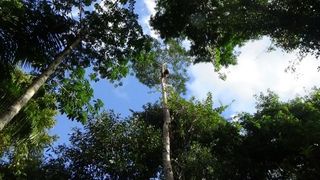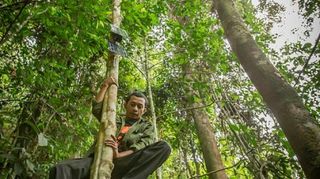Your old smartphone could help save the Amazon rainforest
Discarded electronics become the Guardians of nature

If we ever think about the environmental impact of our upgrade addiction, it's usually to berate ourselves for the damage it does. But there is an option for your old mobile that will not only reduce waste, but actively help to preserve some of the most threatened habitats in the world.
In the last 50 years, 17% of the Amazon rainforest has been destroyed – partly by climate change, but much of it through illegal logging to develop farmland. This is a terrible loss by itself, but it also deprives indigenous tribes of their homes and drives rare species of plants and animals to extinction. There are even wider-reaching effects too: because forests act as a carbon sink, the more we lose, the more CO2 is released into the atmosphere and the greater the potential for global warming.
But there is a way to protect the rainforests, and your old phone could be part of it, thanks to the charity Rainforest Connection. We spoke to CEO Topher White about how your discarded handset could help to save the world.

Guardian angels
Loggers can often be stopped just by warning them off, but the small number of people trying to catch them can't be everywhere at once, especially in an area as vast as the Amazon. That's where Rainforest Connection comes in, with its ingenious Guardian devices.
Each phone is placed inside one of these, which White describes as "a fancy enclosure for protecting a cellphone, giving it a high-power microphone and an extra antenna, and powering it – which is of course the hard part."

The Guardians sit in the trees, listening out for logging activity. The high-powered microphones they contain can pick up the sound of chainsaws and vehicles up to 1km away. When activity is detected, forest rangers can travel to the location and confront the loggers.
These smartphone guardians are currently protecting areas of rainforest in Brazil, Cameroon and Sumatra, and Rainforest Connection plans to expand the project to Ecuador later this year.
Get daily insight, inspiration and deals in your inbox
Get the hottest deals available in your inbox plus news, reviews, opinion, analysis and more from the TechRadar team.
"Simply having someone show up in real time and saying 'you can't be here' and pushing the loggers on their way was an impressive enough event for them to never come back. We don't want to demonise loggers – for the most part they're just doing a job. The safer we can make it for everybody the better."

Safer for indigenous peoples such as the Tembé, who live on a small reserve in the Amazon. "Their survival is tied to the land – it may not be their primary purpose to protect it, but by being there they are able to keep the land more or less persevered," says White.
"The issue is, as more areas around them get damaged and there's increasing encroachment from outside groups, there's more and more pressure on them."
"The Tembé used to inhabit a much larger area, but now there's only about 15,000 of them left and they've been squeezed onto this one reserve that's about 6,000km square. They're pretty much surrounded on all sides by groups that are trying to come in and cut the trees down."

The biggest issue for Rainforest Connection is powering the Guardians. They run on solar energy, and as densely-shaded rainforests aren't the most friendly environment for solar panels the devices have to be carefully positioned.
"Most [solar panels] you see on roofs are very fussy about the shadows you put on them. Even if just a tree branch is in the way it can reduce the power up by to 90%," says White. "In the forest this is the real problem – it's 90% shadow and 10% sunlight. You occasionally have these rays of sunlight coming through the canopy, but they only last for a few minutes."

Those small rays of light are called sun flecks, and they're the only source of power White and his colleagues have to work with. Each guardian has an array of several panels, which are configured to capture the sun flecks when they break through.
"As long as sunlight hits any three or four of these panels then it'll be generating power for the phone," adds White. "One should be able to create more energy then the phone will need over a 24-hour period, but it takes a lot of power to transmit data over these great distances, so we're trying to generate more than 25 watt hours in single day."
James is Managing Editor for Android Police. Previously, he was Senior Phones Editor for TechRadar, and he has covered smartphones and the mobile space for the best part of a decade bringing you news on all the big announcements from top manufacturers making mobile phones and other portable gadgets. James is often testing out and reviewing the latest and greatest mobile phones, smartwatches, tablets, virtual reality headsets, fitness trackers and more. He once fell over.
Most Popular

